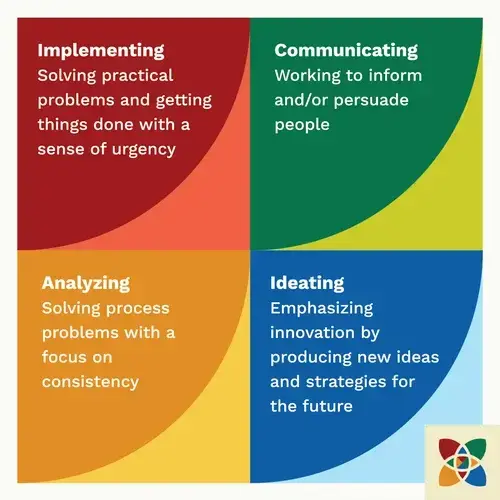How to Create Clarity Around People, Tasks, and Goals
If you asked employees what frustrates them most in their everyday work, unclear expectations might be near the top of the list. From who’s completing which task to why they’re doing the work in the first place, there are many ways leaders can create the clarity needed to create a high-performing team.
We’ve all heard the phrase, “Let’s make sure we’re reading from the same page.” Yet often, teams may feel they’re continually searching for the right page number. Why is this? It comes down to the need for clarity around people, tasks, and alignment. Clarity is achieved when leaders continuously strive to understand and create alignment between the team’s people and tasks, allowing the team to bring its purpose to life. It helps marry individual efforts to common goals, fostering a shared vision and strong sense of direction.
When team members are aligned on how people and tasks help them achieve their purpose, they can work together more effectively, make informed decisions, and create better outcomes. But to help their teams do that, leaders must consider several important questions.
Why Does the Team Exist?
The purpose of the team should be the continual barometer for providing clarity. If your team does not have a purpose statement, creating one should be the first step you take to create clarity and reduce performance risks.
An effective team purpose statement defines the team’s function, key stakeholders, and the impact of the team’s efforts on the organization’s overall goals and vision. When everyone understands the big picture and how it aligns with individual and team contributions, they can work cohesively towards a common objective.
Once the team achieves clarity of purpose, work on clarifying which people will complete which tasks to achieve the outlined goals.
Which Function Are Your People Performing?
There are four functions of a team that affect all stages of a project, from strategy to execution, and help move projects from ideas to going live: ideating, implementing, communicating, and analyzing. The map below illustrates the four different functions in Birkman Colors: Red, Blue, Green, and Yellow.

Teams must know which function they are performing in so they can focus their efforts accordingly and ensure it helps them achieve the team’s purpose. A team’s function will change depending on the current project at-hand or the efforts needed to support the organizational goals.
An intact team of a large organization, such as the accounting department, may be fulfilling the analyzing function a majority of the time. But each member of a team at a small business might be fulfilling a different function from one another and switch between functions for various projects. Clarifying the primary function to be performed at the individual level should begin when possible in the hiring stages but must be reinforced for all employees throughout the duration of their careers.
Each team member has individual strengths that allow them to uniquely contribute to achieving the team’s purpose. Leaders should continually seek to uncover the strengths of each employee and attempt to place them in a function that uses that strength. The result will be a more motivated, engaged team.
What Tasks Are They Completing?
As important as defining the team’s function is clearly defining each member’s role and responsibilities. This ensures everyone understands their specific tasks, areas of ownership, and accountability.
Clarity regarding who is responsible for which task prevents duplication of efforts, helps avoid confusion, and improves overall productivity. It can also help prevent burnout, as 1 in 3 employees report feeling burnout from a lack of clarity on tasks and roles.
When priorities are matched with clarity of responsibilities, teams can focus their time and work on the right tasks. Project management spreadsheets or platforms can help with clearly assigning tasks, due dates, and other key details regarding deliverables. This approach also allows leaders and team members visibility into task progression, creates a detailed approval structure, and provides clarity by keeping all communication and feedback about a task in one central place.
Clear role definition in terms of who is responsible, accountable, consulting, and informing for each initiative also enables effective coordination and delegation within the team. Who can delegate to whom, and who is the escalation point if conflict arises? Without knowing the answers to these questions, teams are not equipped with the clarity they need to overcome obstacles and move projects forward.
How Is Success Measured?
What success looks like and how to measure it should be clearly outlined to avoid the trap of uncommunicated expectations. Is there a weekly scorecard to review? What will be measured: inputs, outputs, outcomes, or impact? When the bullseye is clearly drawn, teams have a much better chance of hitting it.
The purpose of the team should always inform the metrics for success, as this provides the context for how success on your team ladders up to organizational success. If you asked your team members how their success directly contributes to the corporate goals, would they be able to articulate it clearly? If not, there is still work needed to create clarity.
An important note here regarding hitting the bullseye is that teams must have access to the relevant and accurate information they need to complete their tasks. Removing barriers to this access eliminates ambiguity, reduces biases, and enables teams to make decisions based on facts and logic.
Does your team have the evaluation criteria they need to facilitate the decision-making process and make better choices?
You Provided Clarity. Now What?
Creating clarity is an ongoing process, not a task that is checked off and filed away. Teams are doing their best to thrive in a constantly changing environment marked by uncertainty and the ever-present need to adapt. This requires ongoing, intentional efforts to ensure clarity.
You must continually create clarity through methods such as sharing company headlines, scheduling regular status updates, and fostering a psychologically safe environment where team members can share obstacles impeding clarity. These could be as simple as delayed feedback or as complex as feeling the team strays away from its purpose. Either way, anything that stands in the way of your team’s clarity will stand in the way of its success.
Creating clarity for your team has a ripple effect that influences key business outcomes, empowering teams to be more productive and perform at their best. When teams have a clear understanding of expectations of them and how that aligns with their team’s purpose and the organization’s goals, they can prioritize effectively. And that bullseye that seemed a little blurry before? It’s right in front of them, clearly detailed and ready to hit.
Interested in understanding more about clarity and how you can create it for your team? Consider our High-Performing Teams program to get the tools you need. Not only will your team leave knowing their roles and responsibilities, but they’ll determine their purpose and establish psychological safety.

